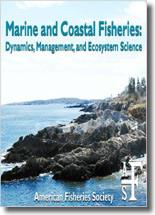We estimated the variation in the instantaneous rates of growth and mortality between cohorts of larval alewife Alosa pseudoharengus and blueback herring A. aestivalis in the Tar-Pamlico River, Pamlico Sound, North Carolina. The age of larvae captured by push net was estimated by counting the daily rings on sagittal otoliths. Weight-at-age and abundance-at-age data were used to generate instantaneous daily growth (G) and mortality rates (M) for 7-d cohorts. The instantaneous daily growth rate was relatively constant between cohorts, ranging from 0.103 to 0.277 for alewives and from 0.105 to 0.200 for blueback herring. The instantaneous daily mortality rate was more variable between cohorts, ranging from 0.064 to 0.270 for alewives and from 0.100 to 0.251 for blueback herring. All but one blueback herring cohort had an M/G value exceeding 1.0, indicating that these cohorts were losing biomass during the early larval stage. For alewives, M/G values were more variable, with 50% of the cohorts having values less than 1.0. The effect of habitat was consistent between species, with M/G values being higher and closer to 1.0 at sites in tributary creeks and backwater areas of Tar River. The overall M/G values were 0.57 for alewives and 1.60 for blueback herring from both backwater and main-channel sites, indicating that the environmental conditions in the Tar—Pamlico River are more favorable for alewives.
How to translate text using browser tools
1 January 2012
Spatial and Temporal Variability in Instantaneous Growth, Mortality, and Recruitment of Larval River Herring in Tar—Pamlico River, North Carolina
Anthony S. Overton





